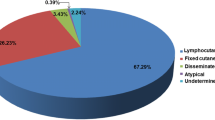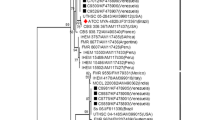Abstract
Sporotrichosis is an uncommon subcutaneous mycosis found throughout the world. Certain tropical and subtropical areas, in particular South America, have regions of hyperendemic disease. Here, we report on the developing genetic diversity of the genus as well as the epidemiology, from the beginnings of the French and South African epidemics through the modern day outbreak in Brazil. The ongoing Brazilian epidemic has led to the discovery of a new species, Sporothrix brasiliensis, and there have been several other clinical and environmental species identified throughout the globe as well. It remains to be seen, however, just what impact this species diversity has on clinical disease.
Similar content being viewed by others
References
Papers of particular interest, published recently, have been highlighted as: • Of importance •• Of major importance
Schenck BR. Refractory subcutaneous abscesses caused by a fungus possibly related to the sporotricha. Bull Johns Hopkins Hosp. 1898;9:286–90.
Hektoen L, Perkins CF. Refractory subcutaneous abscesses caused by Sporothrix schenckii. A new pathogenic fungus. J Exp Med. 1900;5:77–89.
de Beurmann L, Gougerot H. Les sporotrichoses. Paris: Felix Alcan; 1912.
Transvaal Mine Medical Officers’ Association. Sporotrichosis infection in mines of the Witwatersrand: a symposium. Johannesburg, Transvaal Chamber of Mines, 1947.
Ellner PD. An outbreak of sporotrichosis in Florida. JAMA. 1960;173:113–7.
D’Alessio DJ, Leavens LJ, Strumpf GB, Smith CD. An outbreak of sporotrichosis in Vermont associated with sphagnum moss as the source of infection. N Engl J Med. 1965;272:1054–8.
Powell KE, Taylor A, Phillips BJ, et al. Cutaneous sporotrichosis in forestry workers: epidemic due to contaminated sphagnum moss. JAMA. 1978;240:232–5.
Itoh M, Okamoto S, Kariya H. Survey of 200 cases of sporotrichosis. Dermatologica. 1986;172:209–13.
Centers for Disease Control. Multistate outbreak of sporotrichosis in seedling handlers, 1988. MMWR. 1988;37:652–3.
Kushuhara M, Hachisuka H, Yoichiro S. Statistical survey of 150 cases with sporotrichosis. Mycopathologia. 1988;102:129–33.
Kwon-Chung KJ, Bennett JE. Sporotrichosis. In: Kwon-Chung KJ, Bennett JE, editors. Medical mycology. Philadelphia: Lea & Febiger; 1992. p. 707–29.
Barile F, Mastrolonardo M, Loconsole F, Rantuccio F. Cutaneous sporotrichosis in the period 1978–1992 in the province of Bari, Apulia, Southern Italy. Mycoses. 1993;36:182–5.
Hajjeh R, McDonnell S, Reef S, et al. Outbreak of sporotrichosis among tree nursery workers. J Infect Dis. 1997;176:499–504.
Barros MB, Schubach AO, Schubach TM, Wanke B, Lambert-Passos SR. An epidemic of sporotrichosis in Rio de Janeiro, Brazil: epidemiological aspects of a series of cases. Epidemiol Infect. 2008;136:1192–6. A large epidemiologic investigation into the ongoing Brazilian epidemic.
da Rosa AC, Scroferneker ML, Vettorato R, Gervini RL, Vettorato G, Weber A. Epidemiology of sporotrichosis: a study of 304 cases in Brazil. J Am Acad Dermatol. 2005;52:451–9.
Agarwal S, Gopal K, Umesh, Kumar B. Sporotrichosis in Uttarakhand (India): a report of nine cases. Int J Dermatol. 2008;47:367–71.
Gastineau FM, Spolyar LW, Haynes E. Sporotrichosis: report of six cases among florists. JAMA. 1941;117:1074–7.
Dooley DP, Bostic PS, Beckius ML. Spook house sporotrichosis. A point-source outbreak of sporotrichosis associated with hay bale props in a Halloween haunted-house. Arch Intern Med. 1997;157:1885–7.
Flournoy DJ, Mullins JB, McNeal RJ. Isolation of fungi from rose bush thorns. J Okla State Med Assoc. 2000;93:271–4.
de Beer ZW, Harrington TC, Vismer HF, et al. Phylogeny of the Ophiostoma stenoceras-Sporothrix schenckii complex. Mycologia. 2003;95:434–41.
Mesa-Arango AC, Del Rocío Reyes-Montes M, Pérez-Mejía A, et al. Phenotyping and genotyping of Sporothrix schenckii isolates according to geographic origin and clinical form of Sporotrichosis. J Clin Microbiol. 2002;40:3004–11.
Marimon R, Gené J, Cano J, et al. Molecular phylogeny of Sporothrix schenckii. J Clin Microbiol. 2006;44:3251–6.
Marimon R, Cano J, Gené J, et al. Sporothrix brasiliensis, S. globosa, and S. mexicana, three new Sporothrix species of clinical interest. J Clin Microbiol. 2007;45:3198–206.
Madrid H, Cano J, Gené J, et al. Sporothrix globosa, a pathogenic fungus with widespread geographical distribution. Rev Iberoam Micol. 2009;26:218–22.
de Meyer EM, de Beer ZW, Summerbell RC, et al. Taxonomy and phylogeny of new wood- and soil-inhabiting Sporothrix species in the Ophiostoma stenoceras-Sporothrix schenckii complex. Mycologia. 2008;100:647–61.
Madrid H, Gené J, Cano J, et al. Sporothrix brunneoviolacea and Sporothrix dimorphospora, two new members of the Ophiostoma stenoceras-Sporothrix schenckii complex. Mycologia. 2010;102:1193–203. The identification of new species through genetic studies, including potentially linking Sporothrix to Ophiostoma.
Barros MB, Schubach Ade O, do Valle AC, et al. Cat-transmitted sporotrichosis epidemic in Rio de Janeiro, Brazil: description of a series of cases. Clin Infect Dis. 2004;38:529–35.
Schubach AO, Schubach TM, Barros MB. Epidemic cat-transmitted sporotrichosis. N Engl J Med. 2005;353:1185–6.
Schubach TM, de Oliveira Schubach A, dos Reis RS, et al. Sporothrix schenckii isolated from domestic cats with and without sporotrichosis in Rio de Janeiro, Brazil. Mycopathologia. 2002;153:83–6.
Borges TS, Rossi CN, Fedullo JD, et al. Isolation of Sporothrix schenckii from the claws of domestic cats (indoor and outdoor) and in captivity in São Paulo (Brazil). Mycopathologia. 2013;176:129–37. An investigation demonstrating that the Brazilian epidemic centered on cats is limited to Rio de Janeiro.
Pappas PG, Tellez I, Deep AE, et al. Sporotrichosis in Peru: description of an area of hyperendemicity. Clin Infect Dis. 2000;30:65–70.
Lyon GM, Zurita S, Casquero J, et al. Population-based surveillance and a case-control study of risk factors for endemic lymphocutaneous sporotrichosis in Peru. Clin Infect Dis. 2003;36:34–9.
Kovarik CL, Neyra E, Bustamante B. Evaluation of cats as the source of endemic sporotrichosis in Peru. Med Mycol. 2008;46:53–6.
Mata-Essayag S, Delgado A, Colella MT, et al. Epidemiology of sporotrichosis in Venezuela. Int J Dermatol. 2013;52:974–80. An investigation into the at-risk populations identified over the past 40 years.
Laur WE, Posey RE, Waller JD. A familial epidemic of cutaneous sporotrichosis occurring in north Texas. Cutis. 1979;23:205–8.
Park CH, Greer CL, Cook CB. Cutaneous sporotrichosis: recent appearance in Northern Virginia. Am J Clin Pathol. 1972;57:23–6.
Dahl BA, Silberfarb PM, Sarosi GA, et al. Sporotrichosis in children. Report of an epidemic. JAMA. 1971;215:1980–2.
Coles FB, Schuchat A, Hibbs JR, et al. A multistate outbreak of sporotrichosis associated with sphagnum moss. Am J Epidemiol. 1992;136:475–87.
Auld JC, Beardmore GL. Sporotrichosis in Queensland: a review of 37 cases at the Royal Brisbane Hospital. Australas J Dermatol. 1979;20:14–22.
Conias S, Wilson P. Epidemic cutaneous sporotrichosis: report of 16 cases in Queensland due to mouldy hay. Australas J Dermatol. 1998;39:34–7.
Sivagnanam S, Bannan AM, Chen SC, Ralph AP. Sporotrichosis (Sporothrix schenckii infection) in the New South Wales mid-north coast, 2000-2010. Med J Aust. 2012;196:588–90.
Muir DB, Pritchard RC. Sporothrix schenckii–incidence in the Sydney region. Australas J Dermatol. 1984;25:27–8.
Feeney KT, Arthur IH, Whittle AJ, et al. Outbreak of sporotrichosis. Western Australia. Emerg Infect Dis. 2007;13:1228–31.
Yu X, Wan Z, Zhang Z, et al. Phenotypic and molecular identification of Sporothrix isolates of clinical origin in Northeast China. Mycopathologia. 2013;176:67–74. Study of a range of clinical isolates attempting to link phenotypic and molecular information to better understand the differences in the species.
Verma S, Verma GK, Singh G, et al. Sporotrichosis in sub-himalayan India. PLoS Negl Trop Dis. 2012;6:e1673.
Mehta KI, Sharma NL, Kanga AK, et al. Isolation of Sporothrix schenckii from the environmental sources of cutaneous sporotrichosis patients in Himachal Pradesh, India: results of a pilot study. Mycoses. 2007;50:496–501.
Bhutia PY, Gurung S, Yegneswaran PP, et al. A case series and review of sporotrichosis in Sikkim. J Infect Dev Ctries. 2011;5:603–8.
Rajendran C, Ramesh V, Misra RS, Kandhari S. Sporotrichosis in Nepal. Int J Dermatol. 1990;29:716–8.
Haruna K, Shiraki Y, Hiruma M, et al. A case of lymphangitic sporotrichosis occurring on both forearms with a published work review of cases of bilateral sporotrichosis in Japan. J Dermatol. 2006;33:364–7.
Dias NM, Oliveira MM, Santos C, et al. Sporotrichosis caused by Sporothrix Mexicana. Port Emerg Infect Dis. 2011;17:1975–6. Case report of clinical disease caused by a strain previously found only in the environment.
de Oliveira MM, Veríssimo C, Sabino R, et al. First autochthone case of sporotrichosis by Sporothrix globosa in Portugal. Diagn Microbiol Infect Dis. 2014;78:388–90. Case report of the expanding epidemiology of clinical illness.
Pijper A, Pullinger BD. An outbreak of sporotrichosis among South African native miners. Lancet. 1927;2:914–5.
Findlay GH. The epidemiology of sporotrichosis in the Transvaal. Sabouraudia. 1970;7:231–6.
Vismer HF, Hull PR. Prevalence, epidemiology and geographical distribution of Sporothrix schenckii infections in Gauteng, South Africa. Mycopathologia. 1997;137:137–43.
Gumaa SA. Sporotrichosis in Sudan. Trans R Soc Trop Med Hyg. 1978;72:637–40.
El-Mofty AM, Nada M. Sporotrichosis in Egypt. Br J Dermatol. 1965;77:357–64.
Govender S, Rasool MN, Ngcelwane M. Osseous sporotrichosis. J Infect. 1989;19:273–6.
Lesperance M, Baumgartner D, Kauffman CA. Polyarticular arthritis due to Sporothrix schenckii. Mycoses. 1988;31:599–603.
Lurie HI. Five unusual cases of sporotrichosis from South Africa showing lesions in muscles, bones, and viscera. Br J Surg. 1963;50:585–91.
Baum GL, Donnerberg RL, Stewart D, et al. Pulmonary sporotrichosis. N Engl J Med. 1969;280:410–3.
Freitas DF, de Siqueira HB, do Valle AC, et al. Sporotrichosis in HIV-infected patients: report of 21 cases of endemic sporotrichosis in Rio de Janeiro, Brazil. Med Mycol. 2012;50:170–8. A case series description of the disease process in a group of immunocompromised patients.
Kurosawa A, Pollock SC, Collins MP, et al. Sporothrix schenckii endophthalmitis in a patient with human immunodeficiency virus infection. Arch Ophthalmol. 1988;106:376–80.
Kaplan W, Broderson JR, Pacific JN. Spontaneous systemic sporotrichosis in nine-banded armadillos (Dasypus novemcinctus). Sabouraudia. 1982;20:289–94.
Conti Díaz IA. Epidemiology of sporotrichosis in Latin America. Mycopathologia. 1989;108:113–6.
Saravanakumar PS, Eslami P, Zar FA. Lymphocutaneous sporotrichosis associated with a squirrel bite: case report and review. Clin Infect Dis. 1996;23:647–8.
Haddad VJ, Miot HA, Bartoli LD, Cardoso Ade C, de Camargo RM. Localized lymphatic sporotrichosis after fish-induced injury (Tilapia sp.). Med Mycol. 2002;40:425–7.
Cheatwood JL, Jacobson ER, May PG, et al. An outbreak of fungal dermatitis and stomatitis in a free-ranging population of pigmy rattlesnakes (Sistrurus miliarius barbouri) in Florida. J Wildl Dis. 2003;39:329–37.
Crothers SL, White SD, Ihrke PJ, Affolter VK. Sporotrichosis: a retrospective evaluation of 23 cases seen in northern California (1987-2007). Vet Dermatol. 2009;20:249–59.
Morris-Jones R. Sporotrichosis. Clin Exp Dermatol. 2002;27:427–31.
Rex JH, Okhuysen PC. Sporothrix schenckii. In: Mandell GL, Bennett JE, Dolin R, editors. Principles and practice of infectious diseases. 7th ed. Philadelphia: Elsevier Publishing; 2010.
Dominguez-Soto L, Hojyo-Tomoka MT. The intradermal sporotrichin test and the diagnosis of sporotrichosis. Int J Dermatol. 1983;22:520.
Scott EN, Muchmore HG. Immunoblot analysis of antibody responses to Sporothrix schenckii. J Clin Microbiol. 1989;27:300–4.
Barros MB, de Almeida PR, Schubach AO. Sporothrix schenckii and Sporotrichosis. Clin Microbiol Rev. 2011;24:633–54.
Liu X, Zhang Z, Hou B, et al. Rapid identification of Sporothrix schenckii in biopsy tissue by PCR. J Eur Acad Dermatol Venereol. 2013;27:1491–7. This is an important example of non-culture diagnostics becoming increasingly useful in clinical mycology.
Compliance with Ethics Guidelines
Conflict of Interest
TP McCarty declares no conflicts of interest.
PG Pappas has received research grants from Astellas, Merck, Gillead, T2 Biosystems, and Scynexis, and serves on a scientific advisory board for Merck, Gillead, T2 Biosystems, and Scynexis.
Human and Animal Rights and Informed Consent
All studies by PG Pappas involving animal and/or human subjects were performed after approval by the appropriate institutional review boards. When required, written informed consent was obtained from all participants.
Author information
Authors and Affiliations
Corresponding author
Rights and permissions
About this article
Cite this article
McCarty, T.P., Pappas, P.G. The Evolving Epidemiology of Sporotrichosis. Curr Fungal Infect Rep 8, 255–261 (2014). https://doi.org/10.1007/s12281-014-0203-0
Published:
Issue Date:
DOI: https://doi.org/10.1007/s12281-014-0203-0




